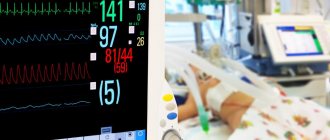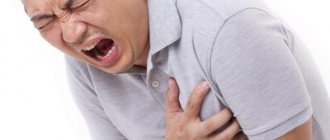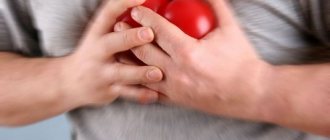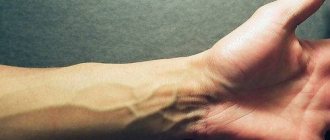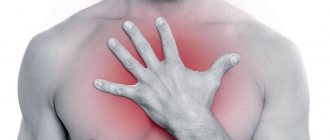Should you worry if your heart hurts when you inhale, cough, sneeze, or run?
One of the most common reasons for visiting a pediatric cardiologist is the child’s pain in the heart area. In most children, such pains are stabbing in nature, but they can also be pressing or pulling.
Table of contents:
- Why does my child have a stabbing or pain in the heart area?
- Common reasons
- What to do?
- Why does a child have heart pain?
- Why does a child's heart hurt?
- Heart pain in a teenager
- A child’s heart hurts – what to do?
- Symptoms of the disease - heart pain in a child
- Pain and its causes by category:
- Pain and its causes in alphabetical order:
- heart pain in children
- What diseases cause heart pain in children:
- Which doctors should you contact if there is heart pain in children:
- Pain in the heart area in a child
- Causes of heart pain ↑
- Clinical picture of cardialgia in children ↑
- Treatment in Kyiv ↑
- Why a child may have heart pain: causes of complaints, symptoms and treatment
- Symptoms of heart pain
- Causes of heart pain in children
- Pain in children under 10 years of age
- Heart pain in teenagers
- Should you worry if your heart hurts when you inhale, cough, sneeze, or run?
- What diseases can the nature of pain indicate?
- Stitching pain
- Pressing pain
- What to do if a child complains of discomfort?
- Heart pain in children
- Characteristics of children's pain in the heart
- The main causes of childhood heart pain
- Which doctor should I contact for heart pain in children?
- Summary for parents
- Several reasons why a 10-year-old child begins to have heart pain
- Common causes of heart pain in children
- Causes of heart pain in children associated with serious heart pathologies
- What to do if a child experiences heart pain?
- Heart pain in children
- General information
- Causes of heart pain in children
- Other causes of pain
- Why did the child begin to complain of heart pain: symptoms of disease, causes and what parents should do
- What parents should pay attention to
- Causes of pain in the heart area
- How to quickly help your child
- Diagnosis and treatment
They are often detected by the child in the area where the apex of the heart is located.
In 80% of cases, the appearance of stabbing pain is preceded by a stressful situation. Most pain in the heart in childhood is not associated with physical activity and does not radiate to other parts of the body. If you distract the child's attention or give him a sedative, the stabbing pain often decreases or disappears altogether.
Single episodes of pain in the heart should not cause concern, but if a child has pain or stabbing in the heart area repeatedly, it is worth going to see a pediatrician or pediatric cardiologist.
The doctor will prescribe additional tests, including an ECG and ultrasound. These are quite informative and safe methods that are easily tolerated by children.
Immediate consultation with a cardiologist is required for children whose heart pain is accompanied by other painful symptoms, for example, fever, joint pain, weakness, or fainting.
With such manifestations, it is important to do tests and the necessary examinations, after which it is imperative to begin treating the child in compliance with all measures prescribed by the cardiologist.
In the next video, Dr. Komarovsky will tell you why there may be pain and stabbing in the chest, and what to do with these sensations.
If a child has a heart problem, then you should not immediately attribute it to age-related changes; it is necessary to understand the causes of such phenomena as quickly as possible.
- Functional pain. Quite often, a child’s heart hurts precisely because of functional disorders, which most often are not associated with the pathology of the heart itself. If we talk about cardialgia in children of early school age, then most often they are explained by “growing pains,” that is, a period of intensive growth of the heart muscle, which the vessels supplying this organ with blood cannot keep up with. You can more often notice pain of this nature in emotional, asthenic, active and mobile children during fast walking, running and various types of physical activity. In this case, the pain goes away as soon as the baby calms down and rests. With cardialgia of this kind, the pain is stabbing in nature and can be repeated many times over several months. In this case, special medical treatment is not required; it is necessary to properly organize the child’s daily routine so that he has time to get enough rest.
- Pathology of various organs. In fact, when there are disturbances in the functioning of individual organs and systems of the child’s body, it is the child’s heart that hurts. The following can project pain to the heart area: the spine (with early osteochondrosis, scoliosis, etc.), the nervous system (with neuroses, etc.), and the gastrointestinal tract (with cholecystocholangitis, biliary dyskinesia, etc.). In general, children quite often incorrectly identify the source of pain, for example, with abdominal pain, the baby may point to the heart area or the chest. Therefore, it is advisable to conduct a full examination.
- Neuroses. In this case, the pain is localized in the area of the apex of the heart and is aching and stabbing in nature. In addition, the child exhibits a number of emotional manifestations, in particular motor restlessness.
- ARVI. Heart pain in a child may also appear against the background of the development of an infectious disease or influenza, which may indicate the development of viral myocarditis. In addition, pain that appears 2-3 weeks after suffering from scarlet fever or tonsillitis may indicate complications, for example, rheumatism begins after a streptococcal infection approximately after this time. In cases of rheumatism or myocarditis, in addition to heart pain, the child notices general malaise, signs of intoxication, joint pain, heart failure, etc. This situation requires immediate consultation with a doctor and the appointment of adequate treatment.
- Cardialgia affecting the heart. In such cases, pain in the heart can be caused by abnormal coronary circulation, a sharp dilation of the great vessels or heart, pericarditis, etc. In these cases, the pain is of a compressive, squeezing nature and is localized behind the sternum (pain can radiate to the jaw, neck, shoulders).
- Postcardiotomy syndrome. There is a dull pain behind the sternum and the temperature rises.
- Pericarditis can cause pleural pain associated with respiratory movements and pericardial pain, manifested by pressing chest pain, similar to myocardial infarction or angina.
Parents must understand that no initiative in treating heart pain should be allowed. If your child experiences pain repeatedly, you should definitely consult a doctor to make an accurate diagnosis.
orthopedist, neurologist, gastroenterologist. This will allow you to determine the presence of diseases of other organs and systems that can initiate pain in the heart area.
The doctor will prescribe the necessary treatment after making an accurate diagnosis. And parents, for their part, can do a lot to normalize the child’s condition:
- Nutrition. You may need to follow a certain diet. In any case, you should once again reconsider the child’s diet, make sure that he receives a sufficient amount of microelements, vitamins and nutrients from food.
- Lifestyle. Organize your child’s daily routine correctly to avoid overload and overwork. Periods of physical activity should alternate with rest and mental stress.
- Emotional background. Pay special attention to the child’s psycho-emotional state, maintain confidential communication and respectful attitude in your family.
Pain in the heart area is not such a rare occurrence in children of all ages - from children 3-4 years old to teenagers. There are quite a few causes of pain, as well as its manifestations.
It is important to identify and exclude health-threatening conditions, which, first of all, include, of course, pathologies of the cardiovascular system. Other causes of heart pain also require careful examination and elimination.
The competence of vertebrologists at the Kyiv “Clinic of Doctor Ignatiev” includes identifying diseases of the spine and other parts of the musculoskeletal system that lead to cardialgia - a pain syndrome with actual or apparent localization in the heart.
Children often develop similar pathologies, which are often perceived as heart disease. But only a detailed examination allows an accurate diagnosis to be made.
Parents have different attitudes towards heart pain in a child. On the one hand, pathological heart pain appears early and is not paid close attention to.
Other parents, in a panic, imagine that their baby has serious heart defects and do all kinds of examinations. Each of them is right in their own way: the sources of pain can be physiological, passing, or they can also indicate problems with the child’s health.
A specialist will be able to recognize the cause after a complete examination of the heart muscle. If the sensations are caused by a disruption in its functioning, therapy should be carried out immediately.
If your child has heart pain, you should definitely see a doctor.
How can you recognize from your baby’s complaints that discomfort is caused by sensations in the heart? Such pain in children is usually characterized in the same way:
- felt in the center of the chest, radiates to the left - to the neck, shoulder, arm, under the shoulder blade;
- short, occur in attacks;
- associated with physical activity, appear in motion;
- caused by psycho-emotional stress;
- described by the child as pressing or stabbing;
- respond well to sedatives.
With problems in the heart, they turn to a pediatrician, who refers them to an ultrasound and ECG to a cardiologist. You may need examinations from other specialists.
- Growing pains. When the growth of blood vessels does not keep pace with the growth of the heart muscle. The child is hyperactive and constantly on the move. The cardiac system cannot cope with physical stress. With a short rest, the pain subsides, but appears regularly over several months. Usually complaints of stabbing pain on the left side of the chest, sometimes radiating to the armpit. You can give motherwort tincture or valerian root, one drop per 1 kg of the child’s weight. But before this, a consultation with a pediatric cardiologist is required.
- Osteochondrosis or scoliosis. A child’s heart pain will vary, it all depends on the nature of the curvature of the spine.
- Neurosis. The pain is aching, accompanied by tingling. Occurs when there is increased physical or emotional anxiety.
- The baby suffered an infectious disease: sore throat, flu, etc. Pain may occur within a month after the illness. Viral carditis and rheumatism develop. The pain is accompanied by general malaise, joint pain, and the initial stage of intoxication.
- Angina pectoris. Sharp pain when coughing, sneezing, deep breathing, running.
- Abnormal coronary circulation. The pain is compressive, radiating to the neck and shoulder area.
- Damage to the blood circulation of the coronary or large vessels most often occurs with congenital heart disease. The pain is dull, radiates to the arm, shoulder, intensifies when coughing.
- Cardiac dysregulation, usually diagnosed in adolescents. The pain is stabbing, localized in the left upper part of the chest, in the absence of physical activity.
- Pericarditis, two types of pain:
- Pleural pain is associated with respiratory movements, aggravated by coughing or deep inhalation, and is caused by the pleuritic component of infectious pleuropericarditis.
- Aching, pressing pain under the chest, varies from slight to sharp, intensifies with a deep breath. Occurs with infectious pericarditis. It can turn into dry, with the pain disappearing, and when examining the baby, a disturbance in the heartbeat can be heard.
Stitching pain
- vegetative-vascular dystonia, disturbance of autonomic regulation of the heart;
- pneumothorax, that is, air entering the pleural cavity of the lungs;
- neuroses;
- dry pericarditis, inflammation of the pericardial sac;
- diseases of the spine (osteochondrosis, curvature);
- heart diseases (defects, rheumatic heart disease, myocardial dystrophy, anomaly of coronary circulation, etc.).
Pressing pain
- localization in the apex of the heart;
- do not have irradiation;
- usually stabbing in nature;
- no connection with physical activity;
- provoked by stress;
- are reduced or blocked by sedatives (calming agents);
- switching children's attention leads to the cessation of pain.
What to do?
Single episodes of pain in the heart should not cause concern, but if a child has pain or stabbing in the heart area repeatedly, it is worth going to see a pediatrician or pediatric cardiologist. The doctor will prescribe additional tests, including an ECG and ultrasound. These are quite informative and safe methods that are easily tolerated by children. If necessary, the child will also be referred to other specialists, for example, to a neurologist or gastroenterologist.
Immediate consultation with a cardiologist is required for children whose heart pain is accompanied by other painful symptoms, for example, fever, joint pain, weakness, or fainting. With such manifestations, it is important to do tests and the necessary examinations, after which it is imperative to begin treating the child in compliance with all measures prescribed by the cardiologist.
In the next video, Dr. Komarovsky will tell you why there may be pain and stabbing in the chest, and what to do with these sensations.
Quite often, parents hear complaints from children even of primary school age about heart pain (or cardialgia). Such complaints should not be ignored, especially in cases where they are repeated. They are not always caused by pathology of the heart itself, but it is necessary to find out their cause.
Common reasons
- Intensive growth of the heart compared to the growth of the vessels that supply it with blood. This growth is observed at the age of 6-10 years. Pain caused by this reason more often appears in emotional and fairly active schoolchildren who have an asthenic physique. In this case, cardialgia may appear after running or other exercise, and as soon as the child rests and calms down, they completely disappear.
- Vegetative-vascular changes that often occur in adolescence. They are manifested by stabbing pain in the left side of the chest, which often occurs at rest.
- Problems with the spine. Any pathologies of its development, for example, scoliosis or early osteochondrosis, can provoke the appearance of pain in the chest, which the child associates with the heart.
- Neurosis or other problems with the nervous system. If the nervous system is affected, nagging or stabbing pain appears in the heart area after physical activity or emotional manifestations.
- Gastrointestinal pathologies. Chest pain may result from cholecystocholangitis or dyskinesia of the pathways through which bile is excreted. However, many children cannot determine the exact source of pain, pointing to the chest if their stomach hurts.
Note that with myocarditis and rheumatism, pain in the heart is not the only manifestation of cardiac pathology. The child develops symptoms of intoxication, high temperature, sensations of interruptions in heart function, joint pain and other signs.
30% of children who have undergone open heart surgery develop dull pain after a few weeks, which is associated with the opening of the heart during surgical treatment.
Gastrointestinal diseases
Reflux esophagitis is becoming increasingly common in children, especially with chronic chest pain of unknown etiology. The pain is located behind the sternum, in the heart area, or both. Increased pain after eating, with increased intra-abdominal pressure or in a lying position is a characteristic, but not obligatory symptom. Esophageal manometry or esophagoscopy can be performed to confirm the diagnosis, but if the history is convincing, a trial of H2-blocker treatment can be started immediately. Less common causes of chest pain include esophageal foreign bodies, achalasia, and diffuse esophagospasm.
What to do if a child experiences heart pain?
If pain attacks occur constantly, this is a good reason to see a doctor and get examined. The pediatrician will send you for an ECG, echocardiography, and, if necessary, an x-ray.
Based on the results of the study, it will be clear what causes pain and which specialist to contact for specialized treatment. If you seek medical help in a timely manner and strictly follow all the doctor’s recommendations, it will be possible to identify serious disorders in time and treat them.
Important! Small children under 5-6 years of age may incorrectly indicate what hurts them. The baby may say that his heart hurts, and if you ask him to show where exactly, he will point his finger at his stomach.
If a child indicates that he has pain in the left side of the chest, this does not mean heart disease or disruption of cardiovascular activity.
In order to correctly diagnose and naturally help the child, it is necessary not only to listen to the complaints of the little patient, but also to contact specialists.
It is very important to pay attention to the exact circumstances under which pain in the heart occurs, whether the child was nervous before this, what he did, was he active, how does the pain manifest itself - strong, weak?
Summary for parents
Some parents mistakenly believe that there is no reason for heart pain in childhood. Others, on the contrary, when the child complains, panicically picture a heart defect in their imagination.
Both opinions are wrong. Children can have heart pain, and most often they are functional in nature, that is, they are not caused by damage to the heart muscle or other structures of the heart. Congenital defects are usually diagnosed by doctors after the birth of the baby based on other manifestations.
The child’s complaints, especially those that are frequently repeated, should not be ignored. It is necessary to contact a pediatrician or pediatric cardiologist, who will examine the child and determine the true cause of the pain in the heart. There are quite a lot of such reasons. Moreover, some of them cannot tolerate delays in treatment. Therefore, you need to contact a doctor immediately.
A child's complaints of pain in the area of the heart muscle do not necessarily mean cardiovascular disease. But most often they consult a doctor for this reason. Typically, children complain of tingling pain in the left upper chest that is not associated with physical activity. When the child is distracted by a game or something else, it quickly passes. It is advisable for parents not to delay a visit to the pediatrician and cardiologist to find out why the child is complaining of heart pain.
In preschool age, the disease is easier to diagnose and prevent. There is no need to scare the child; you should explain to him in a calm voice that a visit to the doctor and examination are necessary. If the cardiologist does not detect heart disease, parents will be offered additional examination by other specialists.
Important! Small children under 5-6 years of age may incorrectly indicate what hurts them. The baby may say that his heart hurts, and if you ask him to show where exactly, he will point his finger at his stomach.
Why does a child have heart pain?
If a child has a heart problem, this should definitely prompt parents to see a doctor and conduct the necessary examination. A qualified doctor will not only be able to determine the location of the pain, but will also identify the cause of such phenomena.
During the examination, the doctor will clarify the sporadic and constancy of painful sensations, the time of their appearance, intensity and distribution. Also, the pediatrician can adequately assess the psycho-emotional and physical stress that the child receives and evaluate other factors that can cause disturbances in the functioning of the cardiovascular system.
According to medical statistics, in approximately 86.9% of cases, heart pain in a child is mainly stabbing in nature and in 96.1% of cases is localized in the area of the apex of the heart.
It was also revealed that in 79.6% of cases, heart pain is provoked by a stressful situation and is not associated with excessive physical activity, does not radiate, decreases or goes away when the child’s attention is switched or when sedatives are used.
However, the reason that a child’s heart hurts can be various diseases or disorders in the functioning of body systems. Let's look at the reasons for heart pain in a child.
Diagnostics
In case of regular manifestation of pain in the heart area in a child, it is necessary to urgently consult a doctor for examination and prescribing diagnostic measures.
Diagnostic methods that are used for these symptoms are as follows:
- taking anamnesis;
- external examination of the child;
- general blood and urine tests;
- electrocardiogram;
- ultrasound examination of the heart.
The listed diagnostic procedures are quite informative and easily tolerated by the child.
Since pain in the heart can be a harbinger of pathological processes spreading to other organs or systems of the body, additional measures such as computed tomography or x-ray examination of the spinal column may be prescribed. You may also need to consult a surgeon, gastroenterologist or neurologist.
Pain in the area of the heart muscle that a child experiences should in no case be ignored. Such a symptom may indicate various abnormalities in the functioning of the body, not necessarily related to the heart muscle. Even rare cases of pain symptoms require contacting a cardiologist.
The number of children complaining of heart pain is growing every year. That is why private clinics have recently been recruiting pediatric cardiologists who are able to identify existing pathologies and diseases of the cardiovascular system in their young patients, which include:
- Rheumatism;
- Hypotension;
- Arterial hypertension;
- Inflammatory diseases, acquired defects and other diseases.
Heart pain in children is one of the main reasons for visiting a pediatric cardiologist. Both children and teenagers can experience pain. It is important for the doctor to establish the location, time of onset, intensity, distribution, connection of pain with physical or psycho-emotional stress, as well as factors causing and alleviating pain.
Doctors note that there are many reasons for pain in the heart area. That is why it is important to identify and exclude health-threatening conditions, which primarily include pathologies of the cardiovascular system.
Heart pain in a teenager
Typically, pain in the heart that appears in adolescence is associated with disorders of the autonomic regulation of the heart, more precisely, it is a consequence of vegetative-vascular dystonia (VSD).
With VSD, pain in the heart is stabbing in nature and localized in the left lobe of the chest and in the left axillary area. Such pain can also appear in a calm state.
If a child develops heart disease during adolescence, this can extremely rarely be the result of a defect. It should be understood that if a heart defect is congenital, then in most cases doctors determine it at an early age.
Psychogenic pain
For many children and adolescents, chest pain is psychogenic. The history often contains indications of mental trauma before the onset of pain, this could be death or coronary artery disease in relatives or friends, divorce, breakup of friendships, school failure or serious illness. Other family members may have similar complaints. The pain is often very vague, and the child has difficulty localizing and describing it. The location and severity of pain may vary. Chest pain occurs with hyperventilation syndrome, depression and somatization disorder. There is often soreness at the apex of the heart.
Briefly about pain in the heart
Children who complain of pain in the heart mainly indicate that they have pain in the heart muscle in the upper part of the chest. Moreover, as a rule, such pain in children appears after prolonged physical exertion, active exercise, or excessive mobility.
Parents can distract the child's attention from unpleasant heart pain (if it is not of a serious origin). If your child is nervous, the pain in the heart can be eliminated with the help of conventional sedatives (calming) drugs.
Clinical picture
Heart pain in a child should never be ignored. If such complaints arise, parents need to regularly monitor the child's condition and interview him.
Following is noteworthy:
- frequency and duration of pain;
- the nature of the discomfort;
- whether the pain is radiating and where exactly it goes;
- presence of shortness of breath due to pain;
- pulse condition;
- whether pain appears after eating a certain type of food;
- heart rate;
- the presence or absence of tissue swelling;
- state of appetite.
Be careful!
Parents of a small child who does not understand and cannot fully explain the localization and nature of painful sensations need to understand that they should not rely only on the children’s words. Why?
For example, your baby may have a very strong stomach ache, and the baby points to his heart. Parents begin to panic and give the baby sedatives or medications that are more serious in their effects.
That is, we conclude that complaints of heart pain from a child may not be real. The causes of unpleasant sensations can be scoliosis, osteochondrosis, problems with the gastrointestinal tract, pain in the liver, kidneys, and lungs.
Who to contact?
See a cardiologist and a therapist. The baby should be referred for consultation to a pediatric cardiologist and pediatrician. To clarify the diagnosis, you will need to conduct an ultrasound diagnosis and an electrocardiogram. If the results of these studies show that the heart muscle is not damaged, then in this case it will be necessary to be further examined by a gastroenterologist, neurologist, and also an orthopedist. Any painful sensations in the cardiac region should never be ignored.
Main Causes of Childhood Heart Pain
The fact is that the vessels supplying blood to the heart do not have time to adapt to the pace of the heart muscle increasing in size. This is observed at the age of 6-10 years.
Pain caused by this factor mainly manifests itself in active and emotional schoolchildren with an asthenic physique. They occur when walking briskly, jogging or during physical activity.
They are often observed in adolescence. In this case, heart pain is a sign of vegetative-vascular dystonia.
The pain is predominantly stabbing in nature. The place where discomfort occurs is the left side of the chest.
Often, pain in the area of the heart muscle is felt due to pathologies of the musculoskeletal system (scoliosis, early osteochondrosis).
A group of diseases of the digestive system may also be a likely cause. Heart pain occurs with gastric dyskinesia, cholecystitis, cholangitis.
It should also be taken into account that a child at an early age may not clearly determine where exactly the pain is localized, and point to the heart when experiencing pain in the hypochondrium or in the epigastric region.
In this case, the child is disturbed by a sharp pain that appears when coughing or breathing movements.
The pain that occurs as a result of such diseases should in no case be ignored. Of particular danger are pain sensations that appear after suffering scarlet fever or tonsillitis, as they can signal the presence of complications of past pathologies: myocarditis of a bacterial or viral nature.
These forms of myocarditis are also characterized by other manifestations:
- bad feeling;
- symptoms of intoxication (headache, poor appetite, weakness, fatigue);
- joint pain;
- heart rhythm disturbances.
If you observe such symptoms, you should immediately contact a pediatric cardiologist or pediatrician, since untimely treatment can provoke the development of heart disease.
Heart diseases
These include:
- impaired blood circulation in the vessels of the heart muscle;
- inflammatory process of the outer lining of the heart;
- unexpectedly formed significant expansion of large vessels or the heart itself;
- endocarditis (the disease can be caused by bacteria);
- cardiomyopathy;
- aortic aneurysm;
- congenital heart defects;
- pathologies of the heart vessels;
- narrowing of the aorta (stenosis);
- transposition of blood vessels;
- rheumatic or infectious pericarditis.
In the latter case, with a deep breath or cough, chest pain of a pressing nature may appear or intensify. Pain in the left side of the chest can be either pronounced or mild. Movement makes the pain even more intense.
Diagnosis and treatment
To find out why the child often complains of heart pain, the baby is taken to a pediatrician and then to a pediatric cardiologist. The cardiologist, first of all, prescribes an ECG (dosed and daily) and an ultrasound of the heart. If cardiac pathology is excluded, you will need to be further examined by other specialists.
To rule out a disorder in the structure of the spine (scoliosis), the orthopedist will refer you for x-rays and computed tomography. If a child feels worse after eating, a consultation with a gastroenterologist is needed to rule out diseases of the digestive system. The child should also be examined by a neurologist to diagnose or refute childhood neurosis.
Parents should not try to diagnose their child themselves. The symptoms of different diseases are often very similar. Whether this disease is cardiological or not can only be determined by experienced pediatric specialists. The sooner the child is examined, the sooner they can help him and prescribe the correct treatment.
General information
Pain in the heart area in children is one of the common reasons for visiting a doctor. It is important for the doctor to clarify their localization, time of appearance, constancy or sporadicness of painful phenomena, intensity, distribution, connection of pain with physical or psycho-emotional stress and other factors. It is important to identify the factors that cause and relieve pain.
Painful sensations in the heart in children are mainly stabbing in nature (86.9%), localized in the apex of the heart (96.1%), provoked by a stressful situation (79.6), do not radiate, are not associated with physical activity, decrease or disappear when the child’s attention is diverted, as well as after taking sedatives.
Causes of heart pain in children
Heart pain in children most often has a functional nature and, as a rule, may not be associated with heart pathology. Cardialgia in children of early school age is usually a manifestation of the so-called growth disease, when the intensive growth of the heart muscle outstrips the growth of the vessels supplying blood to this organ.
Such pain usually occurs in asthenic, emotional, active children against the background of physical activity , fast walking or running. Once the child stops, rests, calms down, the pain goes away. Such cardialgia is usually of a stabbing nature and can be repeated not once, but periodically over several months.
Heart pain in adolescence is usually associated with a violation of the autonomic regulation of the heart, that is, it is a manifestation of vegetative-vascular dystonia . Pain in the heart during VSD is also more often of a stabbing nature, localized in the left half of the chest, the left axillary region, and can occur in a calm state.
Very often, in a child, the pathology of other organs and systems simulates pain in the heart. In the first place is the pathology of the spine (scoliosis, early osteochondrosis). In second place is the pathology of the nervous system (neuroses and others) And, finally, the pathology of the gastrointestinal tract:
biliary dyskinesia;
Typical for children is the inability to correctly localize the source of pain. So, for example, with abdominal pain, a small child may point to the chest, the area of the heart.
Pain in neuroses is usually localized in the region of the heart itself (at the apex), can be stabbing, aching in nature, and is accompanied by a number of emotional manifestations and motor restlessness. Sharp pain with inspiration, coughing , or other respiratory movements usually points to the pleura and pericardial region or mediastinum as a possible source of pain, although pain in the chest wall is also likely to be influenced by respiratory movements. Similarly, pain that regularly occurs when walking quickly and disappears within a few minutes after stopping is still considered a typical sign of angina, although similar phenomena may occur in patients with skeletal disorders and injuries.
Particular attention should be paid if heart pain in a child occurs against the background of an acute current illness (ARVI, influenza), which may indicate the development of viral myocarditis . And also if pain occurs 2-3 weeks after suffering from a sore throat or scarlet fever. After such a time after streptococcal infection, rheumatism begins. With such serious complications as myocarditis and rheumatism, in addition to pain in the heart, other complaints are also disturbing:
joint pain;
interruptions in the heart.
In such a situation, you should immediately consult a doctor. Cardialgia associated with heart damage in children is observed with:
abnormal coronary circulation;
with a sharp expansion of the heart or great vessels.
With an anomalous coronary origin of the left coronary artery from the pulmonary artery (Blandt-White-Garland syndrome), squeezing, squeezing pain, localized behind the sternum, can radiate to the neck, jaw, and shoulders.
Postcardiotomy syndrome : dull pain behind the sternum, fever, arthralgia appear several weeks after surgery, accompanied by opening of the heart cavity, in 30% of operated children. Characterized by expansion of the borders of the heart, increased ESR, increased antibodies to the heart muscle in the blood, which is considered as a hyperergic reaction of the body to damage to the cells of the heart muscle.
Other causes of pain
With pericarditis, there can be two types of heart pain. Pleural pain associated with respiratory movements and aggravated by coughing and (or) deep inspiration is caused by the pleuritic component of infectious pleuropericarditis. The second type of pericardial pain is a pressing retrosternal pain simulating myocardial infarction or angina.
Pain is caused by inflammation of the sensitive internal parietal surface of the pericardium or irritation of the afferent nerve fibers of the heart lying in the periadventitial layer of the superficial coronary arteries. Pain caused by pericarditis is usually expressed as a feeling of pressure. It occurs with infectious or rheumatic pericarditis . The intensity of the pain varies from slight to severe, the pain intensifies with movement and deep inhalation. When dry pericarditis transitions to exudative, pain stops, and at the same time, muffled heart sounds, venous congestion, and a triangular mediastinal shadow appear.
Dull, prolonged pain in the heart area, sometimes with a strong tingling sensation, as well as pain radiating to the left arm and shoulder, as with angina pectoris, can be caused by myocarditis or pericarditis due to acute enlargement of the heart. If the pain is combined with a friction noise synchronous with heartbeats, visible venous congestion in the veins of the neck and hepatomegaly, one should think about pericarditis (characteristic of the x-ray configuration of the heart).
It is also a mistake to believe that heart pain in a child is a manifestation of a heart defect. Congenital heart defects often have other clinical signs. If pain in the heart occurs in an apparently healthy child, but is repeated repeatedly, and the child focuses on it, then there is a need to visit a pediatrician or pediatric cardiologist. It is possible that after examining the heart (ECG and ultrasound), consultations with other specialists will be needed: a neurologist, an orthopedist, a gastroenterologist. They will be able to choose the optimal solution that will help the child recover as soon as possible.
Children often complain to their parents about heart pain. This phenomenon should never be ignored, especially if pain occurs systematically. Not in all cases, the cause of pain is pathology of the heart muscle, so it is necessary to find out the true cause of this phenomenon in order to prevent dangerous complications.


